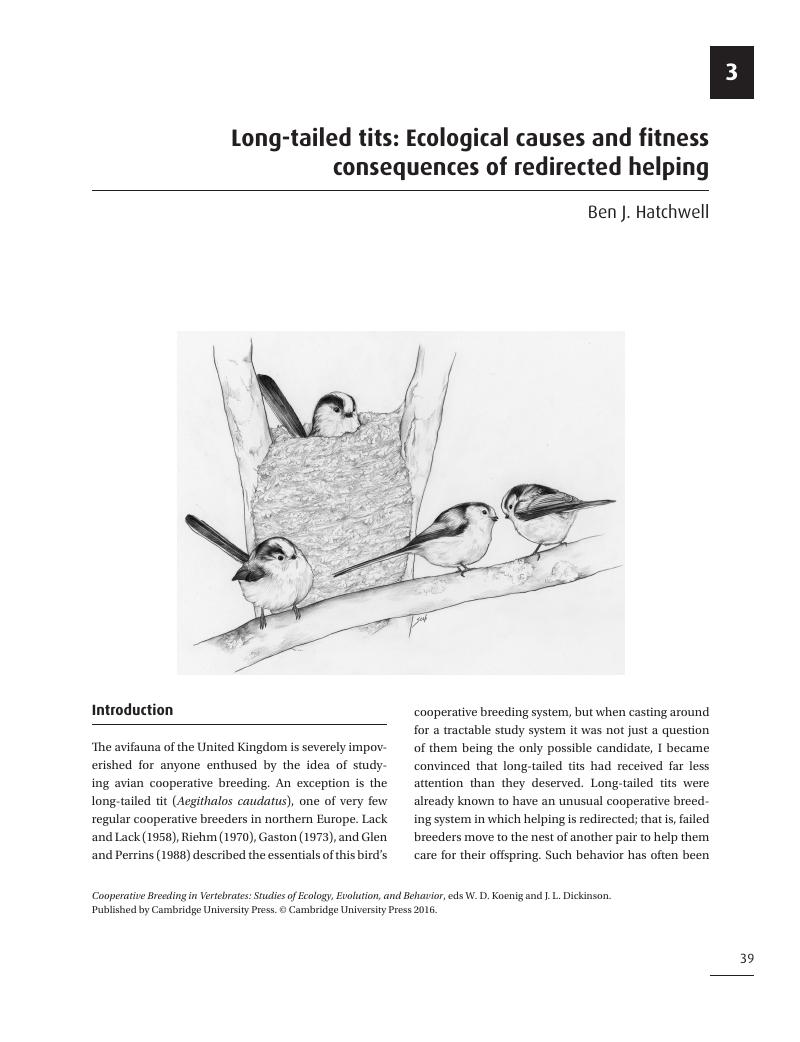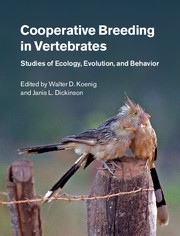Book contents
- Cooperative Breeding in Vertebrates
- Cooperative Breeding in Vertebrates
- Copyright page
- Contents
- Contributors
- Introduction
- 1 Siberian jays: Delayed dispersal in the absence of cooperative breeding
- 2 Western bluebirds: Lessons from a marginal cooperative breeder
- 3 Long-tailed tits: Ecological causes and fitness consequences of redirected helping
- 4 Red-cockaded woodpeckers: Alternative pathways to breeding success
- 5 Florida scrub-jays: Oversized territories and group defense in a fire-maintained habitat
- 6 Carrion crows: Family living and helping in a flexible social system
- 7 Southern pied babblers: The dynamics of conflict and cooperation in a group-living society
- 8 Superb fairy-wrens: Making the worst of a good job
- 9 Chestnut-crowned babblers: Dealing with climatic adversity and uncertainty in the Australian arid zone
- 10 Bell miners: Kin-selected helping decisions
- 11 Superb starlings: Cooperation and conflict in an unpredictable environment
- 12 Seychelles warblers: Complexities of the helping paradox
- 13 Acorn woodpeckers: Helping at the nest, polygynandry, and dependence on a variable acorn crop
- 14 Taiwan yuhinas: Unrelated joint-nesters cooperate in unfavorable environments
- 15 Guira cuckoos: Cooperation, infanticide, and female reproductive investment in a joint-nesting species
- 16 Cichlid fishes: A model for the integrative study of social behavior
- 17 Meerkats: Cooperative breeding in the Kalahari
- 18 Banded mongooses: Demography, life history, and social behavior
- 19 Damaraland and naked mole-rats: Convergence of social evolution
- 20 Synthesis: Cooperative breeding in the twenty-first century
- Index
- References
3 - Long-tailed tits: Ecological causes and fitness consequences of redirected helping
Published online by Cambridge University Press: 18 December 2015
- Cooperative Breeding in Vertebrates
- Cooperative Breeding in Vertebrates
- Copyright page
- Contents
- Contributors
- Introduction
- 1 Siberian jays: Delayed dispersal in the absence of cooperative breeding
- 2 Western bluebirds: Lessons from a marginal cooperative breeder
- 3 Long-tailed tits: Ecological causes and fitness consequences of redirected helping
- 4 Red-cockaded woodpeckers: Alternative pathways to breeding success
- 5 Florida scrub-jays: Oversized territories and group defense in a fire-maintained habitat
- 6 Carrion crows: Family living and helping in a flexible social system
- 7 Southern pied babblers: The dynamics of conflict and cooperation in a group-living society
- 8 Superb fairy-wrens: Making the worst of a good job
- 9 Chestnut-crowned babblers: Dealing with climatic adversity and uncertainty in the Australian arid zone
- 10 Bell miners: Kin-selected helping decisions
- 11 Superb starlings: Cooperation and conflict in an unpredictable environment
- 12 Seychelles warblers: Complexities of the helping paradox
- 13 Acorn woodpeckers: Helping at the nest, polygynandry, and dependence on a variable acorn crop
- 14 Taiwan yuhinas: Unrelated joint-nesters cooperate in unfavorable environments
- 15 Guira cuckoos: Cooperation, infanticide, and female reproductive investment in a joint-nesting species
- 16 Cichlid fishes: A model for the integrative study of social behavior
- 17 Meerkats: Cooperative breeding in the Kalahari
- 18 Banded mongooses: Demography, life history, and social behavior
- 19 Damaraland and naked mole-rats: Convergence of social evolution
- 20 Synthesis: Cooperative breeding in the twenty-first century
- Index
- References
Summary

- Type
- Chapter
- Information
- Cooperative Breeding in VertebratesStudies of Ecology, Evolution, and Behavior, pp. 39 - 57Publisher: Cambridge University PressPrint publication year: 2016
References
- 15
- Cited by

